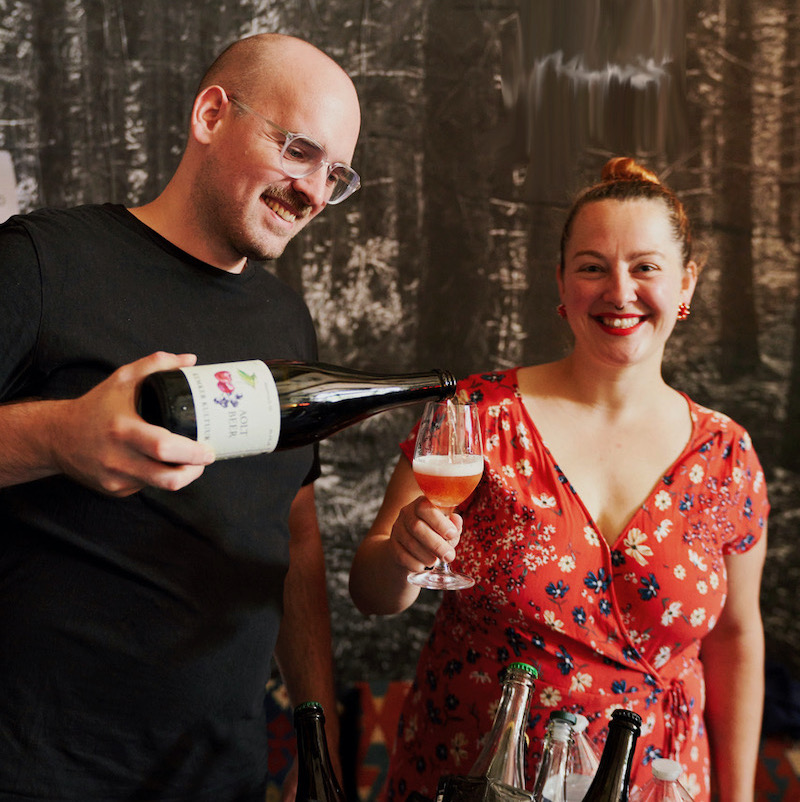Kemker Kultuur

The german famhouse brewery Kemker Kultur has been brewing historic beers in Münsterland since 2017. What Jan once started as an experiment has become a reincarnation of local brewing history. Original ingredients, wild yeasts and long maturation in wooden barrels make their beers unique. We were talking to Jan and Nicole about the diversity of brewing, about community and the hurdles of growing your own ingredients.
Hello Nicole, Hello Jan,
please introduce yourselves as new members of “die Gemeinschaft”and tell us briefly how you came to the historical art of brewing?
Jan and Nicole: We were both born in Münster and have our roots in the region and were always enthusiastic about good food and especially beer. On our travels – especially here in Belgium, England and Scandinavia – we got to know a lively beer culture with some historical beer styles. So the question came up: where is the living beer culture in our hometown? Nonexistent! But after months of research and networking, we came to realise that there was a beer culture here. And a diverse one at that. That was motivation enough to revive it.
Kemker Kultur has been around since 2017, how was and the start for you as a young company in the industry?
Jan: I founded the brewery while I was studying agricultural and food economics. Always with a clear focus on historic beer styles and with a connection to agriculture. As regional, organic and partnership-based as possible.
I made the beginning on a small area in Lienen. At that time, investors could not yet understand this idea and so the foundation came about through bootstrapping. This was not easy, because a brewery is very cost-intensive. The good feedback from Germany but also from neighboring countries was then the driver for an expansion. In 2018, we then converted an old barn into a brewery. Here are now about 100 wooden barrels in which beer and cider mature. The products we make are …
Nicole: ..results of passion and sometimes a bit challenging. They are largely beer and cider. They turn out dry and yet fruity. Depending on the style, you’ll find acidity, bitterness, smoke and herbs. Sometimes a combination of tastes.
In our farm sale you can find not only liquids, but also long-matured sourdough bread, mustard and other delicacies that we wanted to try.
What defines the historic art of brewing?
Nicole: Strictly speaking, that would be working 1:1 as it used to be. That would be historically accurate. Wooden vats, copper kettles heated by fire, wooden barrels, grains of the time, no pumps, etc. But that would be a bit utopian. We are approaching the historical brewing without being forced. We pay attention to the points that are relevant for the product, e.g. old recipes, historical grain and hop varieties, long maturation in wooden barrels and our own yeast culture.
How did you acquire your diverse knowledge of yeast stalks, fermentation, etc.?
Jan: That was almost exclusively through self-study. Visiting other brewers and winemakers was also informative. But the real expertise came from experimenting on my own. Also learning how the yeast behaves in my environment. In other words, every building, every season, different humidity levels are reflected in the product.
“..for us, a long maturation plays an important role for the taste
and is also technically necessary for the fermentation process to be fully completed.”
Why should beer and cider actually be ageing as well?
Nicole: Usually historical beers were always aged products – with a few exceptions. Therefore, for us, a long maturation plays an important role for the taste and is also technically necessary for the fermentation process to be fully completed. Since the invention of artificial cooling and heating technology for pure culture yeasts and pasteurization, beer and cider can be produced faster and more industrially. But at the same time, however, the products have lost their lost their character.
You grow your own barley and the fruit for your beer and cider comes, among other things, from your own orchards. Do you plan to grow even more ingredients for brewing yourself and what potential do you see in it?
Jan: At the moment we do a lot of things in cooperation with organic farmers or farmers who are involved in nature conservation. For example, we are working with the Frecklinghof in Tecklenburg, together we grow the historic “black peacock barley”.With other
farmers we plant new orchards. This is something we want to intensify in the future and perhaps even more consumers, producers and farmers will join in. If we can promote organic products but also nature conservation through meadow orchards, there will be a regional added value
and there might be a chance for a little more diversity in addition to conventional
refinement company’s. Some of our planned agricultural projects we would like to do
in own responsibility, therefore we are looking for land.
Are there any hurdles in the implementation?
Jan: Land is an extremely scarce commodity in our region, with high lease and purchase prices. But we are not discouraged.
Why is it important to you to be part of “die Gemeinschaft”?
Nicole: There is perhaps not “the” reason. But there are certainly many different good reasons. We already know some of the members because they are either customers of ours or we are a customer of theirs. Many of them have needs and that do not always fit into the “normal” framework. Just like we do. At our first meeting at the community, we were able to experience this firsthand how a new context was created for this. And its good to see how quickly our own network expands. Knowing that others have similar hurdles and thoughts creates motivation, inspiration and encourages us to go the extra mile.
Photos:
Pushan Bhowmick